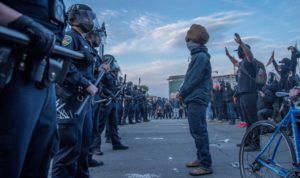
Evidence-based research was the crux of James Q. Wilson’s approach to government policy.
Among his many interests, perhaps the least well-known is that Jim Wilson was a strong advocate of randomized trials in government. He was most engaged with the idea in relation to policing and justice. More broadly, he thought there was far too little testing and too much flying blind in launching government programs. From about 1970 until his death, Jim advocated the use of randomized experiments wherever possible to estimate the cost-effectiveness of programs and policies before they were scaled up and institutionalized. His role was especially influential as Chair of an Attorney General’s Task Force in the first Reagan administration, which led to a golden age of experiments funded by the National Institute of Justice (NIJ), the research arm of the US Department of Justice.
I first met Jim in 1979, when he was in his ninth year of advocacy for experiments in policing. He started down that path at the start of what would be over two decades of his service on the Board of Directors of the Police Foundation. The Foundation had been created by the Ford Foundation in the aftermath of a conservative Congressional outrage over Ford’s hiring of Robert Kennedy’s staff members after RFK was assassinated. After Congress imposed stiff new requirements on all private foundations, Ford Foundation President McGeorge Bundy reportedly decided to undertake an initiative that would align that Foundation’s identity with fairly liberal causes. “Doing something for the cops” was seen to be a good move to assuage Congressional anger. Appointing a Harvard Professor who had recently published Varieties of Police Behavior (1968) as Vice Chairman (and later Chair) of the Police Foundation’s Board was a logical next step.
When the Police Foundation was launched in 1970, the Johnson administration’s creation of a massive Law Enforcement Assistance Administration was widely seen as an incoherent effort to throw federal money at the crime problem. In sharp contrast, the Vera Institute of Justice in New York had fostered massive reforms in pre-trial detention by using controlled experiments. Vera’s first Director, Herbert Sturz, had attracted support for Vera from the Ford Foundation, which then appointed Sturz to serve as another member of the Police Foundation Board. While there is no evidence of Jim Wilson advocating experiments before he met Sturz, it is clear that they became strong partners in pushing the Police Foundation into a strong focus on experiments. While Sturz deserves credit as the founder of modern experimental criminology, Jim Wilson quickly became the most effective national champion of experiments in crime control.
The intellectual background that led Sturz to influence Jim Wilson is explored in a recent biography of Sturz, A Kind of Genius: Herb Sturz and Society’s Toughest Problems. Wilson’s biographers will describe this background as fertile soil for the experimental method. After Wilson’s friend and Harvard colleague Patrick Moynihan (later a US Senator from New York) launched a cogent critique of the War on Poverty, the neo-conservative movement placed a high priority on restraining government spending on untested initiatives. What it did not do was to spell out how government could effectively proceed to think more slowly, as Daniel Kahneman describes it, about solving major social problems. With even President Nixon becoming a big tax-and-spend politician, the small but rigorous testing of the Vera Institute offered a strategy that readily appealed to Jim’s own thinking about fighting urban problems.
My own foray into experiments followed almost immediately after Wilson met Sturz, and the Police Foundation started planning experiments. As an assistant to New York City’s then-Police Commissioner, Patrick V. Murphy, I had been funded by the Police Foundation to write a monograph on neighborhood policing experiments in seven cities. I knew nothing about experiments, but I did know that my Commissioner was launching neighborhood police teams all over New York. That campaign led to many questions in the news media about whether the program “worked,” which led me to wonder what “working” meant. While I spent time writing the monograph as a consultant to the Police Foundation, Kansas City Police Chief Clarence Kelly (who later became Director of the Federal Bureau of Investigation) offered the Foundation an historic opportunity: to conduct an experiment testing the deterrent effects of police patrol. My own involvement in that experiment was peripheral, but I spent enough time in Kansas City to have experiments burnt into my brain at age 22.
What I did not know then was that the experiment would become one of the most expensive—and influential—experiments in the history of criminology. Led by George L. Kelling, who would later co-author the “Broken Windows” theory with Jim Wilson, the Kansas City Preventive Patrol Experiment had Jim’s total support on the Police Foundation Board. Jim later told me he saw no problem in spending millions of dollars in one city on an experiment that could assess the value of billions of dollars of expenditure across the country. The experiment’s conclusion was that the number of police on patrol did not affect the amount or seriousness of crime. That message was a front page headline in the New York Times, a shot heard round the world. On the cusp of a fiscal crisis in American cities, it was followed by massive layoffs of police from New York to California.
While I do not think Jim approved of the layoffs, he never flinched from defending the conclusion of the experiment. His vision was that police would be far more beneficial if their work was much more focused. And while the Kansas City patrol experiment would later be picked apart by statisticians on a number of grounds, its implication that more focused strategies would work better was later supported by the National Research Council’s 2004 report on Fairness and Effectiveness in Policing: The Evidence. In its review of the many police experiments that the Kansas City precedent had made possible, the NRC panel chaired by Wesley Skogan reflected the vision that Jim Wilson had foreseen when he advocated federal funding for most of the experiments the NRC reviewed.
For Jim, Kansas City was just the first of hundreds of experiments that could be done to develop a more cost-effective strategy of policing down the high crime rates of urban America. Thus, when I joined the Police Foundation full time as its Director of Research, he welcomed me with praise for my first research grant from NIJ: a randomized trial of arrests for domestic violence in Minneapolis. He encouraged all of the other experiments I designed and led in my six years at the Foundation, and encouraged my work for three decades after I left it.
He was not always pleased with the results of my experiments. My second domestic violence arrest experiment, in particular, left him skeptical when I found that arrests reduced violence for employed men, but increased it for unemployed men. Labeling theory, or the unintended criminogenic consequences of punishment, did not resonate with him. Yet in five editions of his edited book (later with Joan Petersilia) on crime and public policy, he always let me report whatever I thought the current state of the evidence said about policing.
His unwavering principle was that government could only advance with better knowledge from rigorous tests. This perspective led him to be a strong advocate for federal funding—of experiments. He wrote that research and development of innovations and improvements was a national good. That made research one of the few things in many policy arenas that was absolutely appropriate for a federal role, and inappropriate for state and local investment. His death leaves the federal R&D role with the loss of a major defender. As an advisor to Presidents and Senators, Jim Wilson preached the gospel of “no free lunch” when it comes to evidence-based government. It is hard to see who else will do this now or in the future, at least not with the same impact. But Wilson’s own impact lives on, as reflected in the UK Cabinet Office’s recent symposium promoting more experiments in government at the British Academy.
In remembering Jim Wilson, it is important to recall his support for high-quality (and high-cost) field experiments. He thought such work was a good investment, and morally necessary. He would be happy to have us include this as one of his major legacies to the understanding of law and society.
This essay is part of the Penn Program on Regulation’s online symposium, Remembering James Q. Wilson.




